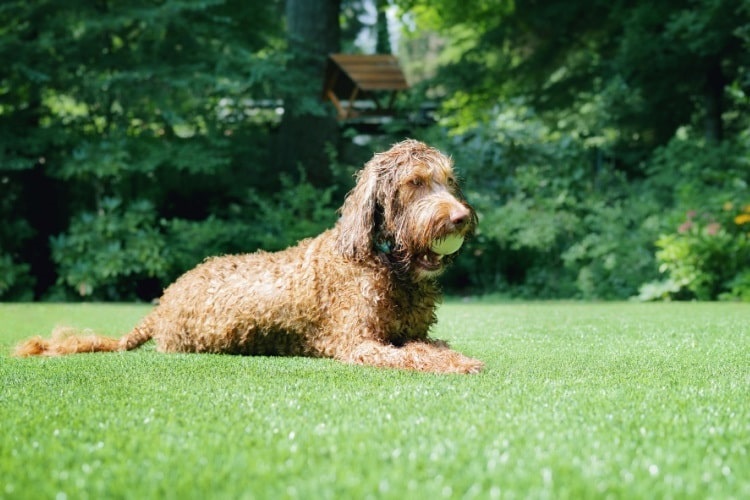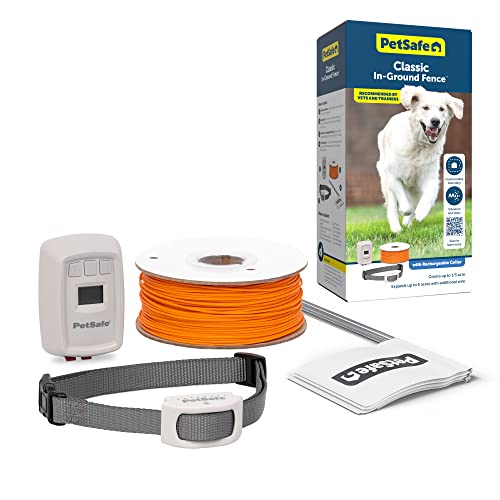In-ground dog fences allow you to keep your dog safe within a perimeter without the unsightly above-ground fences that are traditionally used for containment.
Considering how often Homeowner’s Associations prohibit those types of fences, in-ground fences are becoming more popular than ever.
But where do you start? Don’t worry, we have all the information you need to make your decision.
Our vet advisor, Dr. Jamie Whittenburg, DVM, reviewed a variety of in-ground dog fences to select the products on our list.
She chose the Pet Safe Stubborn Dog In-ground Fence for its reliability and ability to expand — both with multiple collars and extension wires.
While this was Dr. Whittenburg’s top pick, she’s also created a buying guide to help you make sure you’re making the right in-ground dog fence choices for your pup, she’ll explore what dog owners should avoid an in-ground dog fence, and she’s personally selected the best in-ground dog fence for a number of specific use cases.
The 5 Best In-Ground Dog Fences
- Best Overall – Pet Safe Stubborn Dog In-ground Fence
- Best Budget – TTPet Electric Dog Fence, In-ground/Aboveground Pet Containment System
- Best for Stubborn Dogs – Extreme Dog Fence System
- Best Expandable – PetSafe Classic In-Ground Fence for Dogs
- Best for Multiple Dogs – OKPET Wireless Dog Fence Pet Containment System Dog Wireless Fence
In-Ground Dog Fences Compared
Here are the top picks from our veterinarian. Compare the ratings and features of different models.
| Editor’s Picks | Model | Rating | Expandable? | Wire Length | Correction Mode |
|---|---|---|---|---|---|
| Our Vet’s Top Pick | Pet Safe Stubborn Dog In-ground Fence | 500 ft | Tone, Vibration, Static Shock | ||
| Best Budget | TTPet Electric Dog Fence, In-ground/Aboveground Pet Containment System | 650 ft | Tone and Static Shock | ||
| Best for Stubborn Dogs | Extreme Dog Fence | 500 ft | Tone and Static Shock | ||
| Best Expandable | PetSafe Classic In-Ground Fence for Dogs | 500 ft | Tone, Vibration, Static Shock | ||
| Best for Multiple Dogs | OKPET Wireless Dog Fence Pet Containment System, Dog Wireless Fence | 1,000 ft | Tone, Vibration, Static Shock |
*Ratings are on a scale of 1 to 5 and based on reviews, feedback, and opinions of actual customers
In This Article
Types of Dog Fences: An Overview
One common area of confusion for pet owners is the difference between electric dog fences, wireless dog fences, in-ground dog fences, GPS dog fences, and invisible dog fences. Some people will use these terms slightly differently, but here’s a brief overview of the different types of dog fences:
Electric Dog Fence
An electric fence sends electric currents to create a boundary. They can be wireless fences, in-ground fences, or GPS fences. As long as there is a boundary powered by electricity that sends a static shock to your dog for correction, they’re electric dog fences. (Far less commonly, sometimes this refers to the electric fences that are mostly used in farming and are above-ground wires connected by posts.)
Invisible Dog Fences
Invisible dog fences, much like electric dog fences, actually includes a number of subcategories. Also, just like electric dog fences, they can be GPS fences, wireless, or in-ground. They create a perimeter that cannot be seen but, once crossed, will send a signal to a dog collar to correct your dog with multiple levels of static shock. They will often have a beep warning before the dog crosses the boundary so he won’t be surprised by the correction.
In-ground Dog Fence
Though these fences are called in-ground dog fences, some can be used just by lying the wiring on the ground. You may want to secure the wires to the ground with stakes. That said, it’s universally accepted as far more durable and reliable if you bury the fence in the ground (usually somewhere between 3” to 20”).
Wireless Dog Fence
Wireless fences are those that have a base that sends a signal out a specific range (for example, a 500 ft circle surrounding the hub). Once your pup puts on the complementing collar, he’ll be restricted to that circle. When he crosses the boundary, he’ll receive a beep or static shock correction.
GPS Dog Fences
GPS collars allow you to set coordinate boundaries that allow your dog significantly larger ranges. These are ideal for large properties and for pups who go to several different locations. You’ll be able to create parameters around your own home and whichever homes you frequently visit. With GPS monitoring, you’ll often need to pay a small monthly fee, but the reliability is unparalleled.
Who Should Buy an In-Ground Dog Fence
- Pet parents who don’t want to install a traditional fence – Some yards just don’t work with a traditional, above-ground fence. If that’s the case in your yard, an in-ground dog fence may be your best bet.
- Those who aren’t allowed by their HOA – Homeowner’s Associations can be seriously imposing with their regulations. Even those HOAs that don’t have strict rules still often have fence rules. An invisible option like an in-ground dog fence is an excellent method for staying in the clear.
- When your dogs are runners – If your dogs simply can’t be trusted to meander your backyard without bolting off, then you want to create a barrier to keep them safe and secure. An in-ground fence is an excellent option for this.
Who Should Not Buy an In-Ground Dog Fence
- Single dog owners who always have their pup on a leash – If you only take your pup outside on a leash (for example when you’re living in an apartment), then you won’t have to worry about purchasing any kind of dog fence.
- You already have an above-ground fence – You may prefer an in-ground fence, and it may work very well for your pup and home. But if you already have an effective fence in your yard (and you may very well have purchased your home with an established fence), then there’s no need for an in-ground fence — unless, of course, you plan to tear the physical fence down, or if you want to add an in-ground fence as an extra barrier for particularly stubborn dogs.
Buying Guide: Research Tips from a Veterinarian
Always spend some time researching the features and reliability of each fencing system. Speaking to someone who has used the system you are considering can be invaluable. You may also want to ask your veterinarian or other pet care professional for recommendations.
- Remember your circumstances – The first thing to determine before you purchase an in-ground dog fence is your needs. When and where will the fence be used? How large are your dogs? How much space do you need? Does the fencing system need to be portable? Some dogs are amenable to being trained to obey the boundaries of an unseen fence. Others will need to be contained within physical fences if they’re having trouble learning the in-gound fence barrier.
- Customizable shapes – Of electric fences, in-ground fences have the advantage of being able to be placed in any shape or configuration and on uneven ground. Some wireless fences only work in a circle and may have issues with signal obstructions on uneven ground.
- Containing or protecting – It’s essential to note that electric fences like in-ground fences do not protect the dogs inside the boundary area from people, predators, or other pets.
- You’ll still need to train your dog – Patient training is required to help the dog learn the fence’s boundaries. These fencing systems can be frustrating or even ineffective for some dogs.
- Plan for outages – Power outages or failure to recharge the components can lead to fence failure and put your dog at risk of escape and injury. Look for an in-ground fence with battery backup to avoid failures.
- To shock, or not to shock – Lastly, though many systems offer alternative corrections, such as vibration or sound, the static shock correction method may not be acceptable for some owners. Though it isn’t nearly as intense of a shock as you may be imagining, there is still a brief unexpected sensation for your dog.1
How Much Do They Cost?
Between $100 and $500
An in-ground dog fence will likely cost you between $100 and $500. Some of the discrepancies in cost are due to features and quality, but primarily you should expect it to come down to the more fence you need, the more wires you need, and the steeper the cost.
Our Methodology: Why Trust Pet News Daily
As a veterinarian and pet owner myself, I’ve discussed in-ground dog fences several times over the years. Taking into consideration the experiences of other pet owners and vets, I’ve determined the best in-ground dog fences will keep your pup contained and stand the test of time. If you’d like help making that decision and you want it to be someone who knows and understands both you and your dog, consult your veterinarian. She likely knows your dog well enough to make recommendations considering your pup’s demeanor. – Dr. Jamie Whittenburg, DVM
The Best In-Ground Dog Fence Reviews
1. Best Overall – Pet Safe Stubborn Dog In-ground Fence
The Pet Safe Stubborn Dog In-ground Fence‘s multiple correction modes ensure the success of training and containing your dog. The correction mode will fit your well-behaved dog or the most stubborn. The vibration and tone are activated as your pup approaches his boundary and a static shock is activated when he crosses the boundary. You can also expand the system with any PetSafe In-Ground Fence receiver collars (except for the YardMax).
You can design it to fit your yard or your pup’s designated area, making it ideal for odd-shaped spaces. This fence is designed for dogs over 8 pounds and older than 6 months.
- Waterproof collar
- Covers up to 1/3 acre
- Tone, vibration, or static shock correction
- Cannot adjust the correction modes – out of bounds is always a static shock
- YardMax collars are not compatible
2. Best Budget – TTPet Electric Dog Fence, In-ground/Aboveground Pet Containment System
The TTPet Electric Dog Fence, In-ground/Aboveground Pet Containment System is easy to install; use it lying on the ground or bury it, both methods work efficiently. The wire break warning will notify you of any breaks in the wire, so you won’t have to worry about not knowing if there’s a break that’s out of your sight in the ground. You can also control the width of the boundary by adjusting the signal strength on the hub.
By purchasing additional receiver collars, you can control the movements and contain an unlimited number of dogs, making this budget-friendly option an excellent one for multi-pet families. And, should you need extra space, you can extend the boundary by purchasing expansion kits.
- Collar is waterproof
- Rechargeable collar
- Wire break warning
- Not for dogs under 12 lbs
- Not enough training flags to mark the entire fence line
3. Best for Stubborn Dogs – Extreme Dog Fence System
While the first generation of the Extreme Dog Fence System (read our review of extreme dog fence) was an excellent option, this second generation is even better. All the kinks are ironed out, and this in-ground electric fence is ideal for your stubborn pup. You’ll have multiple settings to help train resistant or stubborn dogs.
This fence is made in the USA, and the collar is fully waterproof. It’s easy to install, works on any kind of terrain, and covers up to six acres.
- 20-gauge high tensile boundary wire
- Covers up to 6 acres
- 1-year warranty
- Some customers had poor customer service experiences
- Occasional connectivity issues
4. Best Expandable – PetSafe Classic In-Ground Fence for Dogs
The PetSafe Classic In-Ground Fence for Dogs offers eight levels of correction for your dog so you can set the ideal correction level to warn him when he’s approaching or crossing the perimeter of your fence. An LCD screen displays the boundary distance so you know where it’s set and notifies you if there is a wire break.
The included fence will cover a third of an acre, but you can expand it up to five acres by purchasing additional wire. You can also purchase additional collars for all your dogs (there is no limit to how many).
- 1/3 acre range
- Waterproof collar
- Battery low lights
- Frequently needs to be recharged
- Installation is time-consuming
5. Best for Multiple Dogs – OKPET Wireless Dog Fence Pet Containment System Dog Wireless Fence
The OKPET Wireless Dog Fence Pet Containment System Dog Wireless Fence is perfect when you have three dogs you need to contain. This system comes with three collars, ready to be worn, and 1,000 feet of wire so you can give your dogs the freedom to roam within a generous area.
There are multiple correction levels so you can use this fence for dogs with various temperaments and training levels. First, when your dog approaches the perimeter, there is a vibration warning, followed by a brief static shock if he crosses the boundary. It won’t take long for him to identify the vibration as the correction, so he won’t experience the static correction often.
- Waterproof collar
- 3 collars included
- LCD base unit
- Connectivity issues
- Occasional inaccurate measuring from manufacturer
Frequently Asked Questions
Additional Sources & Resources
Looking for more information about dog fences? We have a library of in-depth information about various aspects of dog fences. Including tips and ideas for keeping your dog from jumping and building your own dog fence:
- 90+ creative and inexpensive dog fence ideas
- DIY dog fence ideas to build your own dog fence
- How to keep a dog from jumping a fence (or climbing a fence)
- How to keep a dog from digging under a fence
- How tall should a dog fence be?
As well as in-depth reviews of each category of dog fence (with recommendations generated by licensed veterinarians):
- The best dog fences (overall)
- The best in ground dog fences
- The best portable dog fences
- The best GPS dog fences
- The best invisible dog fences
- The best wireless dog fences
- The Best Outdoor Dog Fences
And in-depth product reviews of some of the leading dog fence brands:
- Extreme dog fence review
- Justpet dog fence containment system review
- Halo Collar Wireless Dog Fence Review
Article Sources
Pet News Daily uses only high-quality sources, including peer-reviewed studies, to support the facts within our articles. Read our editorial process to learn more about how we fact-check and keep our content accurate, reliable, and trustworthy.
- Buzhardt L, DVM. VCA Animal Hospitals. The Pros and Cons of Invisible Fences for Dogs. Accessed 28 Aug 2022.
- Lesur F. Why underground cables are a better long-term choice for utilities. Power-grid.com. Published 22 Nov 2021. Accessed 29 Aug 2022.





